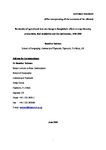Six decades of agricultural land use change in Bangladesh: Effects on crop diversity, productivity, food availability and the environment, 1948-2006
Date
2010-07Author
Subject
Metadata
Show full item recordAbstract
This paper provides a detailed analysis of agricultural land use change in Bangladesh over a 59-year period (1948-2006) and examines how these have impacted crop diversity, productivity, food availability and the environment. The key findings of the analysis are: first, land use intensity has increased significantly over this period, mainly from the widespread adoption of a rice-based Green Revolution technology package beginning in the early 1960s; second, contrary to expectation, crop diversity too has increased; third, although land productivity has increased significantly, declines in the productivity of fertilizers and pesticides raise doubts over sustaining agricultural growth; fourth, food availability has improved, with a reversal in the dietary energy imbalance in recent years despite a high population growth rate; and finally, the production environment has suffered with widespread soil nutrient depletion experienced in many agroecological regions. The policy implication points towards crop diversification as a desired strategy for agricultural growth to improve resource economy, productivity and efficiency in farming in Bangladesh. © 2010 The Author. Journal compilation © 2010 Department of Geography, National University of Singapore and Blackwell Publishing Asia Pty Ltd.
Publisher
Journal
Volume
Issue
Pagination
Recommended, similar items
The following license files are associated with this item:


